Answered step by step
Verified Expert Solution
Question
1 Approved Answer
Why? From the smallest single-celled organism to the tallest tree, all life depends on the properties and reactions of four classes of organic (carbon-based)
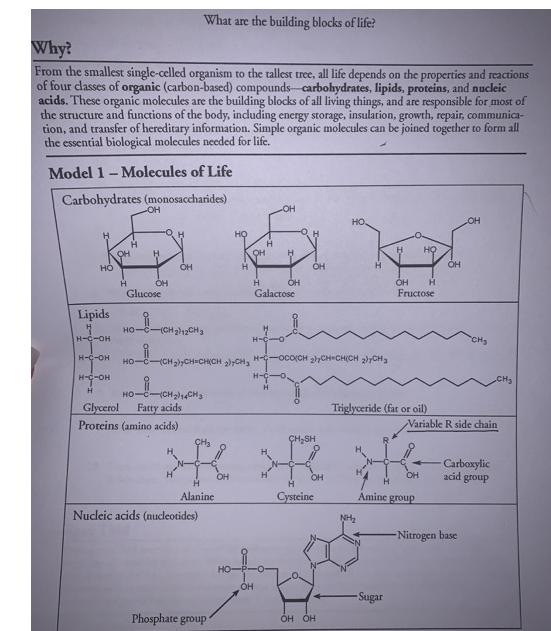

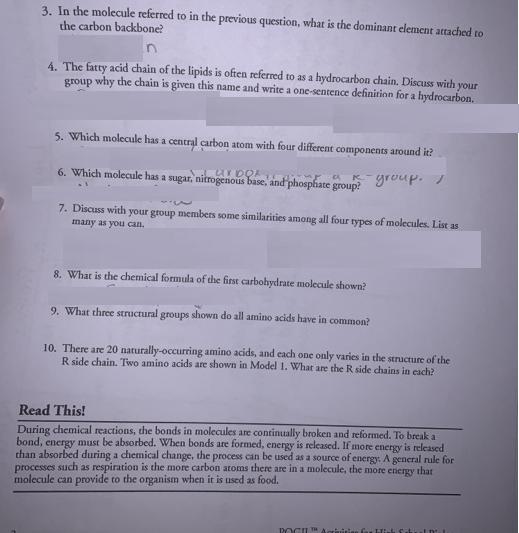

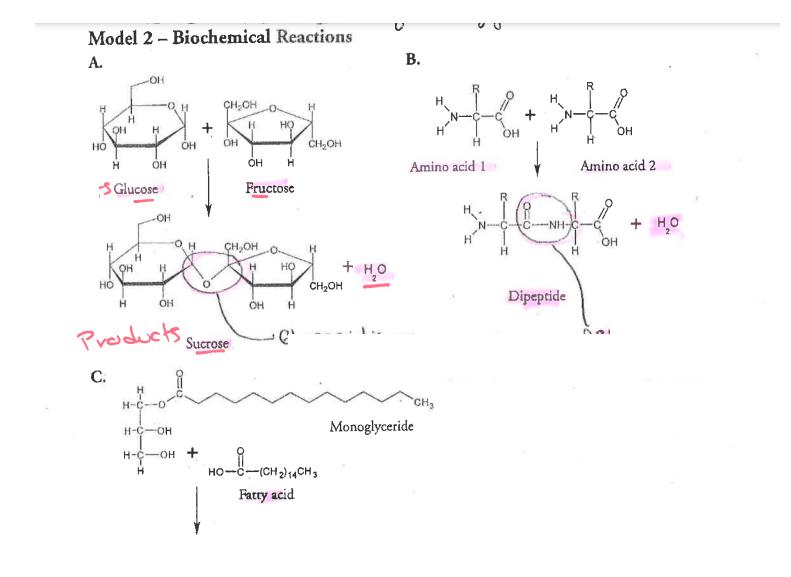
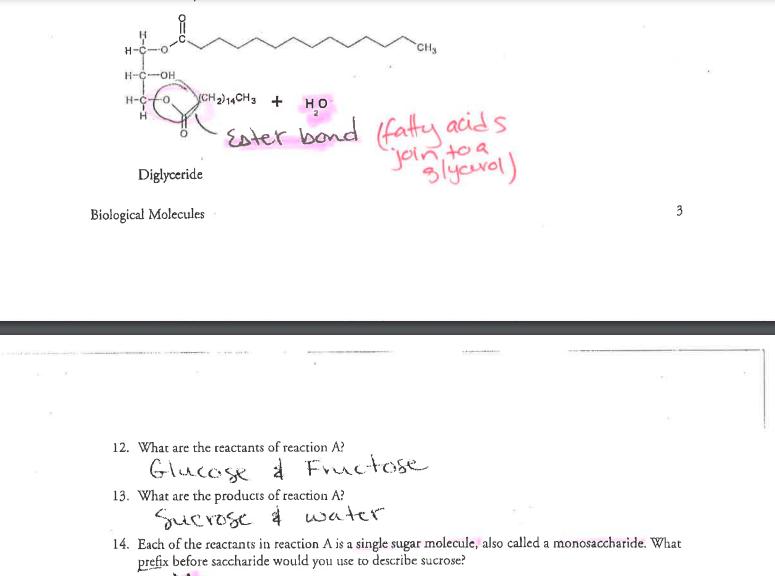
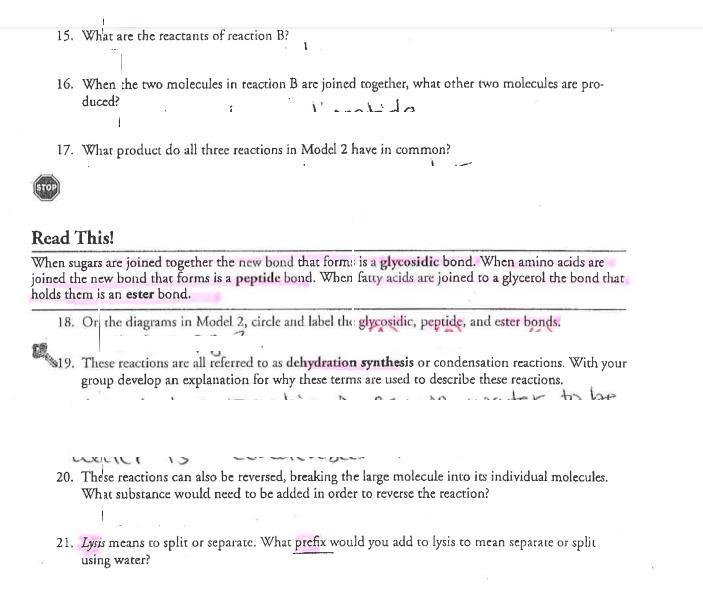



Why? From the smallest single-celled organism to the tallest tree, all life depends on the properties and reactions of four classes of organic (carbon-based) compounds-carbohydrates, lipids, proteins, and nucleic acids. These organic molecules are the building blocks of all living things, and are responsible for most of the structure and functions of the body, including energy storage, insulation, growth, repair, communica- tion, and transfer of hereditary information. Simple organic molecules can be joined together to form all the essential biological molecules needed for life. Model 1 - Molecules of Life Carbohydrates (monosaccharides) HO Lipids H-C-OH H-C-OH H-C-OH H H -OH OH Glucose What are the building blocks of life? OH HO C-(CH2)12CH3 Glycerol Proteins (amino acids) HC CH Cy Fatty acids Nucleic acids (nucleotides) Phosphate group- H OH OH HO H CH2)CH CHCH, CH, HC000CH LCH CHCH CH H-C H-C OH H H Galactose OH OH OH CHSH > >R R OH OH H Alanine Cysteine Amine group OH OH H NH Triglyceride (fat or oil) -Sugar OH H Fructose OH OH CH Variable R side chain -Nitrogen base Carboxylic acid group CH 1. Use Model 1 to show which atoms are present in each type of molecule by listing the symbol for each atom included. Carbohydrate has been done for you. a. Carbohydrate C, H, O b. Lipid-C,H,O c. Amino acid- CH. C. N d. Nucleic acid-C, H, O, N, P 2. Which type of molecule includes an example with a long-chain carbon backbone? 3. In the molecule referred to in the previous question, what is the dominant element attached to the carbon backbone? 4. The fatty acid chain of the lipids is often referred to as a hydrocarbon chain. Discuss with your group why the chain is given this name and write a one-sentence definition for a hydrocarbon. 5. Which molecule has a central carbon atom with four different components around it? K-group. I C 6. Which molecule has a sugar, nitrogenous base, and phosphate group? 7. Discuss with your group members some similarities among all four types of molecules. List as many as you can. 8. What is the chemical formula of the first carbohydrate molecule shown? 9. What three structural groups shown do all amino acids have in common? 10. There are 20 naturally-occurring amino acids, and each one only varies in the structure of the R side chain. Two amino acids are shown in Model 1. What are the R side chains in each? Read This! During chemical reactions, the bonds in molecules are continually broken and reformed. To break a bond, energy must be absorbed. When bonds are formed, energy is released. If more energy is released than absorbed during a chemical change, the process can be used as a source of energy. A general rule for processes such as respiration is the more carbon atoms there are in a molecule, the more energy that molecule can provide to the organism when it is used as food. POCI Accivision for Mist Citiem. 11. Using the information from above, is a carbohydrate or a lipid more likely to be a good source of energy for an organism? Model 2 - Biochemical Reactions A. H CHOH H H HO OH OH BD OH OH H HO OH H C. H H Glucose HO -OH OH H H-C-0 Fructose H-C-OH H-C-OH + H H -OH + HO CHOH OH H H H HO Bug 4g. OH Dipeptide Products, Sucrose OH H CHOH H CHOH H-C(CH2)CHy Fatty acid B. + HO Amino acid 1 HIGH+ OH Monoglyceride D CH OH Amino acid 2 Bai H H-CIO H-C-OH H-Co Diglyceride Biological Molecules +214 CH3 + HO Ester bond (fatty acids join to a 3lycrol) 12. What are the reactants of reaction A? CH Glucose & Fructose 13. What are the products of reaction A? Sucrose & water 3 14. Each of the reactants in reaction A is a single sugar molecule, also called a monosaccharide. What prefix before saccharide would you use to describe sucrose? 15. What are the reactants of reaction B? 1 16. When the two molecules in reaction B are joined together, what other two molecules are pro- duced? 1 l'antido 17. What product do all three reactions in Model 2 have in common? STOP Read This! When sugars are joined together the new bond that form is a glycosidic bond. When amino acids are joined the new bond that forms is a peptide bond. When fatty acids are joined to a glycerol the bond that holds them is an ester bond. 18. On the diagrams in Model 2, circle and label the glycosidic, peptide, and ester bonds. $19. These reactions are all referred to as dehydration synthesis or condensation reactions. With your group develop an explanation for why these terms are used to describe these reactions. for to be LAXILICE 20. These reactions can also be reversed, breaking the large molecule into its individual molecules. What substance would need to be added in order to reverse the reaction? 21. Lysis means to split or separate. What prefix would you add to lysis to mean separate or split using water? 22. Using your answers to the previous two questions, what word is used to describe the reaction that uses water to break apart a large molecule? Hydrolysis. STOP POGIL Activities for High School Biology Extension Questions 23. Metabolism is the collective term used to describe all the chemical reactions taking place inside living organisms. Why is water so important for metabolic reactions? ( 24. We store excess food in our body either in the form of carbohydrates (in muscles and the liver) o or as fat (adipose tissue). When our body needs additional energy it uses the carbohydrate source first as a source of "quick" energy, then the fat. Why do you think carbohydrates are used as a source of quick energy rather than fat? Use complete sentences and scientific terminology in your response. 1 tl Inc. 1 Look at the two types of fatty acids below, saturated and unsaturated. What is the difference between the two? Jee D H H-C-H H-C-H H-CH H-C-HI H-C-H HOT Saturated Fatty Acid H-C-H C-H H-C H-C-H H-C-H HO O d W Unsaturated Fatty Acid 26. Saturated fats are solid fats, like the animal fats lard and butter, whereas unsaturated fats are more fluid and form oils, such as vegetable oil. Trans fats are plant oils that are artificially solidified to make them suitable for baking purposes. In recent years trans fats have been associated with negative health issues and are not as widely used. Explain in simple molecular terms what would have to be done to a plant oil to transform it to a trans fat.
Step by Step Solution
★★★★★
3.34 Rating (151 Votes )
There are 3 Steps involved in it
Step: 1

Get Instant Access to Expert-Tailored Solutions
See step-by-step solutions with expert insights and AI powered tools for academic success
Step: 2

Step: 3

Ace Your Homework with AI
Get the answers you need in no time with our AI-driven, step-by-step assistance
Get Started


